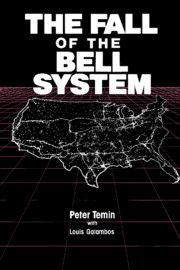Book contents
1 - Setting the Stage
Published online by Cambridge University Press: 06 January 2010
Summary
The regulated monopoly
The Bell System of 1971 was distinguished not only by its size and the problems it faced, but also by the unique relationships it had established over almost a century of dealing with state and federal governments. (For AT&T's size, see Table 3.) The System had grown initially in the midst of turmoil over the rise of modern corporate enterprise, contemporary with the emergence of state regulation and the creation of the Interstate Commerce Commission (ICC), AT&T's first federal regulator. But for a nation accustomed to small enterprises, the size and power of the modern corporation were difficult to accept. Many Americans at the turn of the century were unhappy with the prospect of regulation; they questioned whether giant firms like AT&T should be allowed to exist, regulated or not. This view gave rise to the Sherman Antitrust Act, passed shortly after the formation of the ICC. Congress in effect told the federal executive that it should either regulate or prosecute monopolies. But Congress did not indicate how that choice was to be made. Instead of locating the decision in a single office, it was left to be made through bargains and implicit understandings between federal and state regulatory agencies and the Department of Justice.
AT&T soon confronted this crucial ambiguity in public policy. Although the company moved adroitly to fashion a compromise that preserved its position as a regulated monopoly, it continued to be at risk that its performance would not satisfy one or more of the government bodies with which it dealt and that the bargains it made would begin to unravel.
- Type
- Chapter
- Information
- The Fall of the Bell SystemA Study in Prices and Politics, pp. 9 - 27Publisher: Cambridge University PressPrint publication year: 1987
- 2
- Cited by



